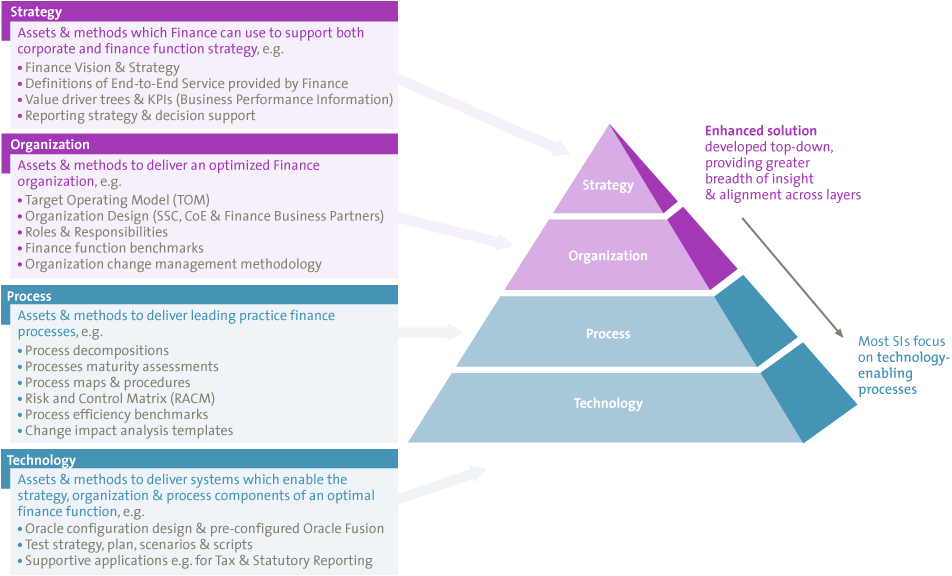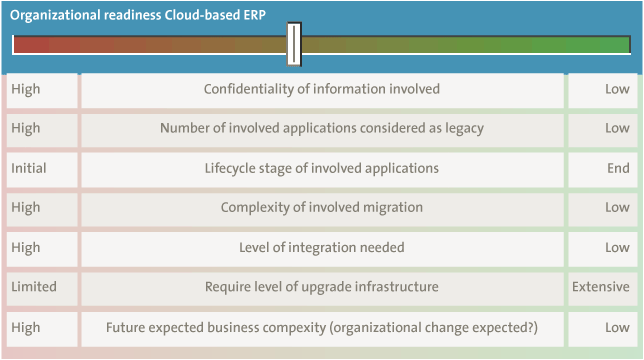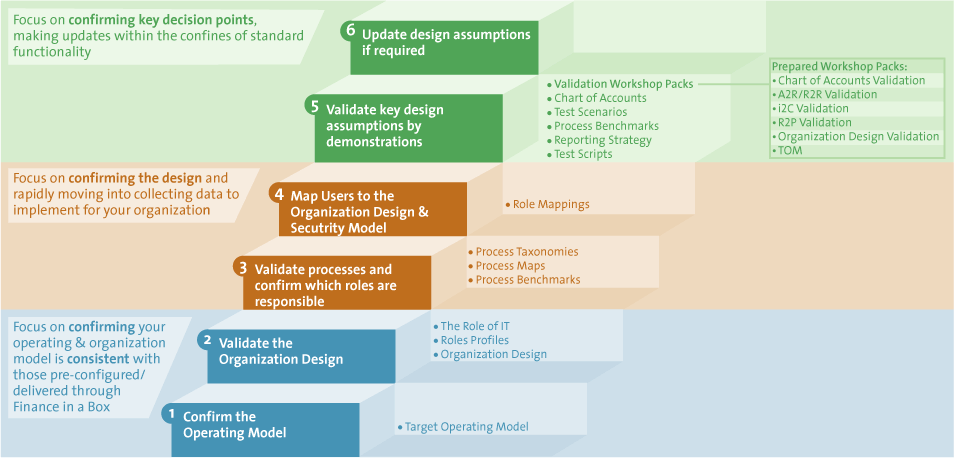At present, large ERP suppliers in particular are strongly promoting the idea that even the more core ERP processes (such as Finance and Supply Chain Management) are ready to step into the Cloud, as this will also lead to significant cost reductions in these areas. However, one could argue that Cloud-based ERP is merely an attempt by large suppliers to reposition their ERP solutions in order to compete with smaller suppliers with flexible and often cheaper solutions. If they apply the key principles of the Cloud, organisations will definitely be able to harvest the benefits of ERP in a more optimum way. However, not all organisations are ready for this step at this moment in time.
Introduction
In a market where Cloud-based ERP solutions for CRM and HR have definitely gained ground ([KPMG13]), one could argue that the step to other parts of ERP (such as Finance and Supply Chain Management) is easily made. This is endorsed by the fact that more and more organisations are also considering the ‘Cloud’ for these core ERP areas. The main drivers of these developments are:
- The fact that operations are no longer fit for purpose. Expanding companies are faced with a myriad of heterogeneous processes, as well as siloed and decentralized finance teams, all leading to lower performance. To support corporate decision making, Finance typically creates an industry of offline processes.
- The high cost of service provision. Most organizations incur costs of up to 40 percent greater than their top quartile peers. These high costs are driven by high numbers of staff (50 percent more FTEs), operating in a siloed manner, and managing their business through a complex web of systems.
- Lack of available insight. In most organizations, good access to the high-quality information required for effective decision making remains a constraint. Most organisations produce large volumes of reports each month, and spend a disproportionate amount of time on manually extracting data from systems and manipulating them in Excel.
- Unexploited value from the ERP platform. Whilst most Finance functions have embraced the use of ERPs, most have often failed to use them to eliminate or automate routine tasks. In some organizations, this is deliberate, but all too often it is the consequence of de-scoping when ERP programs overrun.
Despite the fact that solution providers give the feeling that the transition to the Cloud is some sort of ‘plug and play’ process, recent studies have shown that bringing your ERP system to the Cloud is definitely no sinecure ([KPMG12]). By addressing the current status of the ERP market in the Cloud, key developments, and the impact on the organisations from a business and a process point of view, this article is able to explain whether the implementation of Cloud solutions represents real innovation or merely renovation of possibly outdated ERP solutions.
Key developments around Cloud-based ERP solutions
Due to ongoing and significant investments by the ERP suppliers, Cloud computing, and Software as a Service (SaaS) now offer an interesting alternative to regular ERP implementations. The Cloud can namely be an interesting cost-reduction opportunity in these areas, as it offers a service model based on constantly up-to-date software, enforces standardization, provides the flexibility to diversify and to scale operations in response to changing business circumstances, and enables greater productivity through increased multi-device accessibility. It is therefore no surprise that 51 percent of Finance organizations will use SaaS to support more than half of its transactions by 2016, rising to 81 percent post-2017 (source: Gartner).
The above trend can be accelerated by the interesting development that ERP providers are now partnering with business consultancy firms to enrich their Cloud solution by providing an integrated suite of strategy, organization, process and technology. The assets and methods within these propositions enable the accelerated delivery of Finance Transformations – reducing both cost and risk. Our experience shows that 80 percent of the process-related configuration is standard across companies. Therefore the implementation of a pre-built system, which comprises some 80 percent of the final configuration, could be an interesting alternative. Rather than having to redesign a system from scratch to meet customer needs, customers only need to ratify this core (there is some flexibility even within this). By focusing on ratification, the need to engage with as many people as possible in the client’s organization will be reduced significantly. Having a pre-built core means spending the available time on the organization-specific 20 percent, and on business transformation.
In order to realize the above-mentioned steps successfully, the enriched solutions offer more capabilities to effectively implement the Cloud solution by paying explicit attention to the strategic layer and the organizational layer, by providing predefined guidelines and tools. In our view, these are crucial aspects to introduce core ERP components (such as Finance and SCM) into the cloud.

Figure 1. Building blocks enriched ERP solutions in the cloud (source: KPMG’s Powered Finance).
Whereas the implementation of regular Cloud-based ERP focuses too much on the technical and process layers, the four dimensions of Strategy, Organisation, Process and Technology apply to ‘regular’ ERP implementations. However, whereas regular ERP solutions often end up in lengthy implementations due to the fact that too much time is spent on matching the technical dimension to the organisational and process dimension, the enriched Cloud-based ERP solutions offer an extensive set of steering mechanisms to prevent this pitfall. But this latter option requires a mind shift within most organizations. Therefore the key question is whether or not this type of solution is interesting and feasible for all organisations.
Is Cloud-based ERP a good solution for all organisations?
Over the past few years, organisations have become increasingly enthusiastic about Cloud solutions. Originally, Cloud initiatives were mainly focused on Office solutions, creating a basis to convince organisations that ERP components could also be brought into the Cloud. As mentioned, point solutions such as HR and CRM were the first Cloud-based ERP solutions, but core ERP elements have now also been brought into the Cloud. As recent studies have shown that these developments can no longer be ignored, discussions have started on whether or not these Cloud solutions can be applied to all types of organisations.
A recent study published by Gartner ([Rayn14]) advises CIOs and application leaders of financial services institutions to “consider Cloud-based ERP as a potential replacement for aging core ERP systems that are out of support or running on old technology platforms (such as mainframes).” The study shows that 47 percent of all organisations surveyed were planning to move their core ERP systems to the Cloud within 5 years ([Colu14]). In addition, major ERP vendors like Oracle state that 2014 was the first year that the Cloud pipeline exceeded the on-premise pipeline.
The adoption of these Cloud solutions is expected to differ per organisational type. Research shows that service-centric organisations will lead, and product-centric organisations will follow. Gartner research shows that, by 2018, at least 30 percent of service-centric companies will move the majority of their ERP applications to the Cloud ([Gart14]). It is interesting to note that governmental organisations tend to lag behind in the adoption of Cloud-based ERP. However, with most governmental organisations facing declining budgets and the general idea that Cloud solutions eventually bring about IT cost reduction, the discussions are becoming more and more lively. Nevertheless, we still nurture reservations about taking Cloud-based ERP as a good alternative for the majority of governmental organisations. The main reason for this lies in the complexity of ERP architecture at governmental organisations, in connection with the high degree of integration required. This complexity demands an interoperability that is, in our experience, still limited with most Cloud-based ERP solutions. In addition, legal restrictions and concerns with security and privacy still play an important role. This last reservation might also apply to private organisations, but the level of confidentiality is higher for most governmental organisations, as this not only involves privacy and the sensitive personal information of civilians, but often also involves information relating to national security in instances such as the departments of Defense, Justice etc. In addition, there is the continuous public debate on the security aspects of the Cloud.
When considering the private market, we consider Cloud-based ERP to be a good solution for small and medium-sized enterprises (SME). To these SMEs, the main driver is cost-effectiveness. An on-premise ERP implementation was always very expensive for these organisations, due to upfront investments in software, hardware and infrastructure, and the need for IT specialists once ERP was up and running. As SMEs have a relatively low number of users, the monthly subscription fee is often lower than the operational costs and upfront investments are no longer required. In addition the organisation can be professionalized by implementing the best of breed / standard processes that are preconfigured within Cloud-based ERP solutions (the next section provides more information on processes).
The above-mentioned advantages also apply to large enterprises, but the advantages to these organisations in the long run seem to be less obvious because of the high number of user subscriptions, for instance, which drastically increase the monthly costs and therefore directly affect the business case. As the number of users grow, the initial advantages of the monthly subscription model – which is mostly used for Cloud-based ERP solutions – decrease . The monthly Cloud-based ERP subscription costs for these large enterprises might be higher than the operational IT costs plus write-offs of the initial investments.
Despite the fact that SMEs seem to be the prime target for Cloud-based ERP, one cannot say that Cloud-based ERP is a good solution for all SMEs and will only work for large enterprises and governmental organisations to a limited extent. The reality is that a solid business case is always required before making such a decision. It is important that several aspects are carefully taken into account when deciding if Cloud-based ERP is the way forward for your organisation. Table 1 can be regarded as a support model when considering Cloud-based ERP and when determining whether or not an organisation is mature enough for the introduction of Cloud-based ERP.

Table 1. High-level checklist Organisational readiness for Cloud-based ERP (source: KPMG).
Once the decision has been made that Cloud-based ERP is the way forward, the organisation needs to carefully manage the impact on the organisation, keeping in mind that the impact will be bigger when core ERP (like Finance) is being affected.
How does Cloud-based ERP impact the internal (IT) organisation?
Before starting any implementation, organizations need to realize and accept that the processes and/or organisation aspects/structure involved will need to change in cases of critical functionality gaps. As changing people and processes is usually considered to be more difficult than changing software, this is a big challenge to Cloud-based ERP projects, and should not be underestimated. As mentioned, in our view, traditional Cloud-based ERP solutions are mainly technology-driven and pay attention to the strategic, organisational and process dimension of an implementation only to a limited extent.
It is therefore crucial to execute a fit-gap analysis early in the project in order to determine missing business functionality and possibly missing data (elements). Having executed the fit-gap analysis, the organisation must decide whether or not possible gaps are business-critical. Before starting the implementation with ERP in the Cloud, it is important that the organisation realize that there are limitations to changing/customizing the software. Where on-premise ERP can always be tailored to the customer’s needs, ERP in the Cloud cannot be customized as the software is shared and not owned by the customer.
Once the Cloud-based ERP solution is operational, the main part of the solution will be maintained by the software vendor and no longer by the internal IT organisation. This impacts the existing organisation, as the division of tasks between the internal organisation and the ERP vendor has changed. However, it is important to note that this does not necessarily mean a reduction in FTE. Although IT resources such as database administrators, developers, designers etc. will be no longer internally required, other resources such as business analysts and resources involved in vendor and SLA management will increase. So whereas many resources were previously involved in upgrading, patching and supporting activities, for instance, resources are now working more closely with the business by examining new solutions and ways to improve business and to add value. In this way, IT can shift from being seen as a cost post to actually being part of the business.
The shift from on-premise ERP to Cloud-based ERP entails opportunities for and threats to existing IT staff, and may create significant organisational disruptions that must be taken into account. The organisational process of change involved should not be taken lightly, but should be planned and guided carefully. Clear communication is key in this process. In general, this has more impact on larger enterprises.
Organisations that operate worldwide can benefit greatly from ERP in the Cloud. They no longer need IT staff at each location worldwide because support is done centrally by the ERP vendor. The reduction of hardware at each location can also diminish the number of local IT staff needed. Another impact on the IT organisation can be that (first-line) support can be outsourced to the ERP vendor. This latter point can also be realized when an organisation has implemented on-premise ERP but, in that case, an organisation still needs to have its own support group. In contrast, with ERP in the Cloud, multiple organisations can use the same support organisation provided by the ERP vendor.
The organisation can also benefit from the experience of the ERP Vendor. If there are bugs or issues with the ERP in the Cloud solution, the EPR vendor must quickly provide a solution, because all of the organisations are experiencing the same problem. Another advantage of ERP in the Cloud is that if one organisation experiences an issue while working with ERP in the Cloud, and the ERP vendor has solved this issue, the ERP vendor can rollout the solution to all the other organisations that use the same Cloud.
Implementation approach of Cloud-based ERP
During the actual implementation, it is important that the organisation realizes that there are limitations to changing/customizing the Cloud-based ERP software. Whereas on-premise ERP can always be tailored to the customer’s needs, ERP in the (public) Cloud cannot be customized, as the software is shared and not owned by the customer. Adjusting the software would impact multiple tenants. Cloud-based ERP solutions can be configured, but it is important to realize that key functionality cannot be changed and missing functionality and data cannot be added. For example: an organisation has the flexibility to create reports if these are not provided as part of the standard solution, but missing data can never be part of these reports of course. Recent market experiences have demonstrated that if the guiding principle of “standard functionality is leading” is not applied, Cloud-based ERP will never get off the ground.
To realize the true benefits of Cloud-based ERP, therefore, not only the solution itself should be innovative but the implemental approach should be characterized by innovation too. Here again we see a difference between the traditional Cloud-based ERP solutions and the enriched solutions. Both focus on eliminating lengthy design cycles. However, the advantage of the enriched solutions is that these solutions contain predefined toolkits and templates, allowing the project team to start the implementation directly with core system walkthroughs (i.e., validation sessions of the system). By focusing on ratification rather than on designing, fewer key people in the client’s organisation are required for a shorter time. Walkthroughs of the Cloud-based ERP solution with these key stakeholders are scheduled. The underlying design is explained to them and they are guided though options in which not all of the 80 percent fits the client’s business model. With the help of a pre-built core, most of the time can be spent on the 20 percent of specific requirements, using guided workshops to confirm the configuration required. Thus, in summary, it can be stated that the big advantage of the implemental approach to the enriched solutions is the focus on “confirmation” instead of on “investigation” (see also Figure 2).

Figure 2. Example of an accelerated-implementation approach (source: KPMG’s Powered Finance).
Concluding remarks
Cloud-based ERP compels an organisation to introduce a high level of standardization in its business processes and information requirements. In essence, Cloud-based ERP is not really innovative, but could be considered as some sort of renovation of the old premise “Standard, unless…” Innovation is definitely required, not only from an application point of view but also from an organisational point of view in order to really benefit from Cloud-based ERP. Enriched Cloud-based ERP solutions, in which not only the solution itself but also the implemental approach is incorporated with its predefined toolkits and approaches, can support organisations in this change. However it must to be emphasized that, if an organisation wishes to embark upon the Cloud journey, a thorough analysis is required to investigate whether or not the perceived objectives meet the goals of the organisation. If this kind of exercise is not performed, this road will definitely not become an innovative road, but rather a road that requires much renovation, with a large risk of running into the same issues as regular ERP implementation in the past.
References
[Colu14] L. Columbus, Why cloud ERP adoption is faster than Gartner predicts, 17 February 2014, http://www.cloudcomputing-news.net/news/2014/feb/17/why-cloud-erp-adoption-is-faster-than-gartner-predicts/
[Gart14] Gartner, Gartner Says By 2016, the Impact of Cloud and Emergence of Postmodern ERP Will Relegate Highly Customized ERP Systems to “Legacy” Status, 29 January 2014, http://www.gartner.com/newsroom/id/2658415
[KPMG12] KPMG, KPMG International’s 2012 Global Cloud Providers Survey, 2012.
[KPMG13] KPMG, Breaking Through the Cloud Adoption Barrier, KPMG’s 2013 Cloud Providers Survey, 2013.
[Rayn14] N. Rayner, Survey Analysis: Adoption of Cloud-based ERP, 2013 through 2023, Gartner, 24 January 2014, https://www.gartner.com/doc/2656317/survey-analysis-adoption-cloud-erp






